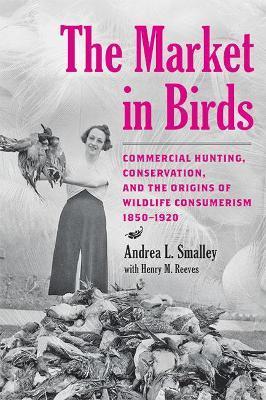The Market in Birds: Commercial Hunting, Conservation, and the Origins of Wildlife Consumerism, 1850-1920

The Market in Birds: Commercial Hunting, Conservation, and the Origins of Wildlife Consumerism, 1850-1920
A fascinating look at how a commercial market for birds in the late nineteenth century set the stage for conservation and its legislation.
Between the end of the Civil War and the 1920s, the United States witnessed the creation, rapid expansion, and then disappearance of a commercial market for hunted wild animals. The bulk of commercial wildlife sales in the last part of the nineteenth century were of wildfowl, who were prized not only for their eggs and meat but also for their beautiful feathers. Wild birds were brought to cities in those years to be sold as food for customers' tables, decorations for ladies' hats, treasured pets, and specimens for collectors' cabinets. Though relatively short-lived, this market in birds was broadly influential, its rise and fall coinciding with the birth of the Progressive Era conservation movement.
In The Market in Birds, historian Andrea L. Smalley and wildlife biologist Henry M. Reeves illuminate this crucial chapter in American environmental history. Touching on ecology, economics, law, and culture, the authors reveal how commercial hunting set the terms for wildlife conservation and the first federal wildlife legislation at the turn of the twentieth century. Smalley and Reeves delve into the ground-level interactions among market hunters, game dealers, consumers, sportsmen, conservationists, and the wild birds they all wanted. Ultimately, they argue, wildfowl commercialization represented a revolutionary shift in wildlife use, turning what had been a mostly limited, local, and seasonal trade into an interstate industrial-capitalist enterprise. In the process, it provoked a critical public debate over the value of wildlife in a modern consumer culture.
By the turn of the twentieth century, the authors reveal, it was clear that wild bird populations were declining precipitously all over North America. The looming possibility of a future without birds sparked intense debate nationwide and eventually culminated in the 1918 Migratory Bird Treaty Act. Scholars, environmentalists, wildlife professionals, and anyone concerned about wildlife will find this new perspective on conservation history enlightening reading.
PRP: 588.51 Lei
Acesta este Pretul Recomandat de Producator. Pretul de vanzare al produsului este afisat mai jos.
529.66Lei
529.66Lei
588.51 LeiLivrare in 2-4 saptamani
Descrierea produsului
A fascinating look at how a commercial market for birds in the late nineteenth century set the stage for conservation and its legislation.
Between the end of the Civil War and the 1920s, the United States witnessed the creation, rapid expansion, and then disappearance of a commercial market for hunted wild animals. The bulk of commercial wildlife sales in the last part of the nineteenth century were of wildfowl, who were prized not only for their eggs and meat but also for their beautiful feathers. Wild birds were brought to cities in those years to be sold as food for customers' tables, decorations for ladies' hats, treasured pets, and specimens for collectors' cabinets. Though relatively short-lived, this market in birds was broadly influential, its rise and fall coinciding with the birth of the Progressive Era conservation movement.
In The Market in Birds, historian Andrea L. Smalley and wildlife biologist Henry M. Reeves illuminate this crucial chapter in American environmental history. Touching on ecology, economics, law, and culture, the authors reveal how commercial hunting set the terms for wildlife conservation and the first federal wildlife legislation at the turn of the twentieth century. Smalley and Reeves delve into the ground-level interactions among market hunters, game dealers, consumers, sportsmen, conservationists, and the wild birds they all wanted. Ultimately, they argue, wildfowl commercialization represented a revolutionary shift in wildlife use, turning what had been a mostly limited, local, and seasonal trade into an interstate industrial-capitalist enterprise. In the process, it provoked a critical public debate over the value of wildlife in a modern consumer culture.
By the turn of the twentieth century, the authors reveal, it was clear that wild bird populations were declining precipitously all over North America. The looming possibility of a future without birds sparked intense debate nationwide and eventually culminated in the 1918 Migratory Bird Treaty Act. Scholars, environmentalists, wildlife professionals, and anyone concerned about wildlife will find this new perspective on conservation history enlightening reading.
Detaliile produsului








